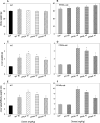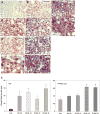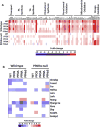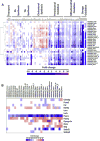Perfluoroalkyl acids-induced liver steatosis: Effects on genes controlling lipid homeostasis
- PMID: 28049043
- PMCID: PMC5994610
- DOI: 10.1016/j.tox.2016.12.007
Perfluoroalkyl acids-induced liver steatosis: Effects on genes controlling lipid homeostasis
Abstract
Persistent presence of perfluoroalkyl acids (PFAAs) in the environment is due to their extensive use in industrial and consumer products, and their slow decay. Biochemical tests in rodent demonstrated that these chemicals are potent modifiers of lipid metabolism and cause hepatocellular steatosis. However, the molecular mechanism of PFAAs interference with lipid metabolism remains to be elucidated. Currently, two major hypotheses are that PFAAs interfere with mitochondrial beta-oxidation of fatty acids and/or they affect the transcriptional activity of peroxisome proliferator-activated receptor α (PPARα) in liver. To determine the ability of structurally-diverse PFAAs to cause steatosis, as well as to understand the underlying molecular mechanisms, wild-type (WT) and PPARα-null mice were treated with perfluorooctanoic acid (PFOA), perfluorononanoic acid (PFNA), or perfluorohexane sulfonate (PFHxS), by oral gavage for 7days, and their effects were compared to that of PPARα agonist WY-14643 (WY), which does not cause steatosis. Increases in liver weight and cell size, and decreases in DNA content per mg of liver, were observed for all compounds in WT mice, and were also seen in PPARα-null mice for PFOA, PFNA, and PFHxS, but not for WY. In Oil Red O stained sections, WT liver showed increased lipid accumulation in all treatment groups, whereas in PPARα-null livers, accumulation was observed after PFNA and PFHxS treatment, adding to the burden of steatosis observed in control (untreated) PPARα-null mice. Liver triglyceride (TG) levels were elevated in WT mice by all PFAAs and in PPARα-null mice only by PFNA. In vitro β-oxidation of palmitoyl carnitine by isolated rat liver mitochondria was not inhibited by any of the 7 PFAAs tested. Likewise, neither PFOA nor PFOS inhibited palmitate oxidation by HepG2/C3A human liver cell cultures. Microarray analysis of livers from PFAAs-treated mice indicated that the PFAAs induce the expression of the lipid catabolism genes, as well as those involved in fatty acid and triglyceride synthesis, in WT mice and, to a lesser extent, in PPARα-null mice. These results indicate that most of the PFAAs increase liver TG load and promote steatosis in mice We hypothesize that PFAAs increase steatosis because the balance of fatty acid accumulation/synthesis and oxidation is disrupted to favor accumulation.
Keywords: Perfluorohexane sulfonate; Perfluorononanoic acid; Perfluorooctane sulfonate; Perfluorooctanoic acid; Steatosis; Triglycerides.
Published by Elsevier B.V.
Figures







Similar articles
-
PPARα-independent transcriptional targets of perfluoroalkyl acids revealed by transcript profiling.Toxicology. 2017 Jul 15;387:95-107. doi: 10.1016/j.tox.2017.05.013. Epub 2017 May 27. Toxicology. 2017. PMID: 28558994 Free PMC article.
-
The effects of perfluorinated chemicals on adipocyte differentiation in vitro.Mol Cell Endocrinol. 2015 Jan 15;400:90-101. doi: 10.1016/j.mce.2014.10.020. Epub 2014 Nov 5. Mol Cell Endocrinol. 2015. PMID: 25448844
-
Evaluating the additivity of perfluoroalkyl acids in binary combinations on peroxisome proliferator-activated receptor-α activation.Toxicology. 2014 Feb 28;316:43-54. doi: 10.1016/j.tox.2013.12.002. Epub 2013 Dec 26. Toxicology. 2014. PMID: 24374136
-
Immunotoxicity of perfluorooctanoic acid and perfluorooctane sulfonate and the role of peroxisome proliferator-activated receptor alpha.Crit Rev Toxicol. 2009;39(1):76-94. doi: 10.1080/10408440802209804. Crit Rev Toxicol. 2009. PMID: 18802816 Review.
-
Endocrine disrupting properties of perfluorooctanoic acid.J Steroid Biochem Mol Biol. 2011 Oct;127(1-2):16-26. doi: 10.1016/j.jsbmb.2011.03.011. Epub 2011 Mar 21. J Steroid Biochem Mol Biol. 2011. PMID: 21397692 Free PMC article. Review.
Cited by
-
Environmental Pollution and the Developmental Origins of Childhood Liver Disease.Hepatology. 2020 Nov;72(5):1518-1521. doi: 10.1002/hep.31549. Hepatology. 2020. PMID: 32910501 Free PMC article. No abstract available.
-
Dose Response, Dosimetric, and Metabolic Evaluations of Replacement PFAS Perfluoro-(2,5,8-trimethyl-3,6,9-trioxadodecanoic) Acid (HFPO-TeA).Toxics. 2023 Nov 22;11(12):951. doi: 10.3390/toxics11120951. Toxics. 2023. PMID: 38133352 Free PMC article.
-
Perfluorooctanesulfonic Acid and Perfluorohexanesulfonic Acid Alter the Blood Lipidome and the Hepatic Proteome in a Murine Model of Diet-Induced Obesity.Toxicol Sci. 2020 Dec 1;178(2):311-324. doi: 10.1093/toxsci/kfaa148. Toxicol Sci. 2020. PMID: 32991729 Free PMC article.
-
Perfluorooctanoic acid activates multiple nuclear receptor pathways and skews expression of genes regulating cholesterol homeostasis in liver of humanized PPARα mice fed an American diet.Toxicol Appl Pharmacol. 2020 Oct 15;405:115204. doi: 10.1016/j.taap.2020.115204. Epub 2020 Aug 19. Toxicol Appl Pharmacol. 2020. PMID: 32822737 Free PMC article.
-
Role of xenobiotics in the induction and progression of fatty liver disease.Toxicol Res (Camb). 2018 May 18;7(4):664-680. doi: 10.1039/c7tx00326a. eCollection 2018 Jul 1. Toxicol Res (Camb). 2018. PMID: 30090613 Free PMC article. Review.
References
-
- Anderson SP, Dunn C, Laughter A, Yoon L, Swanson C, Stulnig TM, Steffensen KR, Chandraratna RA, Gustafsson JA, Corton JC. Overlapping transcriptional programs regulated by the nuclear receptors peroxisome proliferator-activated receptor alpha, retinoid X receptor, and liver X receptor in mouse liver. Mol Pharmacol. 2004;66:1440–1452. - PubMed
-
- Angrish M, Kaiser J, McQueen C, Chorley B. Tipping the balance: hepatotoxicity and the 4 apical key events of hepatic steatosis. Toxicol Sci. 2016;150:261–268. - PubMed
-
- Begriche K, Massart J, Robin MA, Bonnet F, Fromently B. Mitochondrial adaptations and dysfunctions in nonalcoholic fatty liver disease. Hepatology. 2013;58:1497–150. - PubMed
-
- Berthiaume J, Wallace KB. Perfluorooctanoate, perflourooctanesulfonate, and N-ethyl perfluorooctanesulfonamido ethanol; peroxisome proliferation and mitochondrial biogenesis. Toxicol Lett. 2002;129:23–32. - PubMed
Publication types
MeSH terms
Substances
Grants and funding
LinkOut - more resources
Full Text Sources
Other Literature Sources
Miscellaneous

